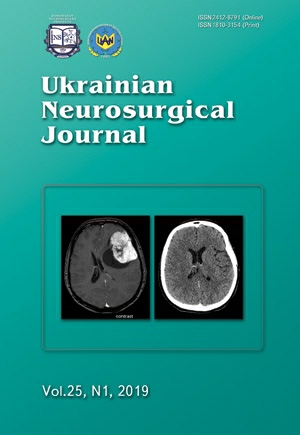Features of diagnosis and surgical treatment of acute dislocation syndrome in patients with intracranial cystic meningiomas
DOI:
https://doi.org/10.25305/unj.153091Keywords:
dislocation syndrome, cystic meningiomas, diagnosis, surgical treatmentAbstract
Objective: to determine the peculiarities of diagnosis, the clinical course of dislocation syndrome (DS) in patients with cystic meningiomas, depending on the shape and degree of brain dislocation and methods of their surgical treatment.
Research objectives: to study the results of treatment of patients with DS in the postoperative period, depending on the form and degree of DS.
Materials and methods. There have been conducted clinical and instrumental examinations, as well as surgical treatment of 38 (100 %) patients with cystic meningiomas, who were hospitalized to the Department of Non-Cerebral Tumors and Endoscopic Neurosurgery, State Institution of Romodanov Neurosurgery Institute of NAMS of Ukraine, in 2010–2017. Thirty (78.94 %) patients had acute DS before the operation and 18 (47.36 %) patients experienced it in the postoperative period. The selection criteria for patients was DS along with cystic meningiomas aged 20 to 70 years old, without combined TBI, abscesses and somatic pathology. The female patients 2.1-fold prevailed (26:12) over the male patients.
Results. In the case of the cingular dislocation, good treatment results occurred in 73.4 % of cases. With temporal tentorial dislocation, in 35.78 % of cases the results of treatment were negative, and with temporo-tentorial and foraminal dislocations the results of treatment were negative in almost 100 % of cases.
Conclusions. The dislocation complications could be prevented with methods reducing elevated intracranial pressure, eliminating the insertion of structures of the great brain by radical removal of cystic meningiomas using modern surgical technologies and modern pathogenetic early complex drug intensive care.
References
1. Vasil'ev DV. [Anesthetic aspects of brain dislocation syndrome]. Georgian Med News. 2014 Dec;(237):13-8. Russian. [PubMed]
2. Bidot S, Saindane AM, Peragallo JH, Bruce BB, Newman NJ, Biousse V. Brain Imaging in Idiopathic Intracranial Hypertension. J Neuroophthalmol. 2015 Dec;35(4):400-11. [CrossRef] [PubMed]
3. Solodov AA, Petrikov SS. Giperosmolyarnyye rastvory v komplekse lecheniya bol'nykh s vnutricherepnymi krovoizliyaniyami. Vestnik intensivnoy terapii. 2009;(2):22-27. https://elibrary.ru/item.asp?id=20162750
4. Olyushin VY, Ulitin AY, Safarov BI. Sindrom sdavleniya i dislokatsii golovnogo mozga pri opukholevom porazhenii. Prakticheskaya onkologiya. 2006;7(2):113-116. Russian. http://practical-oncology.ru/assets/articles/342.pdf
5. Lebedev VV, Krylov VV. Dislocation syndrome in acute neurosurgical disease. Russian Journal of Neurosurgery. 2000;(1-2):4-11. Russian. https://elibrary.ru/item.asp?id=21689478
6. Kondakov EN, Klimash AV, Bahtiyarov AK, Bokin VD. Supratentorial traumatic brain herniation. Nevrologicheskiy vestnik. Zhurnal im. V.M. Bekhtereva. 2008;40(3):19-24. Russian. https://elibrary.ru/item.asp?id=11669860
7. Kadyrov R.M. Brain compartment syndrome and brain dislocation in neurooncologic patients. Vestnik KGMA im. I.K. Akhunbayeva. 2015;3(1):65-68. Russian.
8. Lysenko SM. [The brain dislocation and its significance in surgical treatment of patients with glioma of supratentorial localization]. Klin Khir. 2005 Sep;(9):43-6. Ukrainian. [PubMed]
9. Verbova L.N. Gipertenzionno-dislokatsionnyye sindromy i lechebnaya taktika pri nikh. Ukrainian Neurosurgical Journal. 2005;(3):53-56. Russian.
10. Puras JuV, Talypov AE, Krylov VV. Decompressive craniotomy in acute period of severe head injury. Russian Journal of Neurosurgery. 2011;(3):19-26. Russian. https://elibrary.ru/item.asp?id=16972404
11. Louis DN, Perry A, Reifenberger G, von Deimling A, Figarella-Branger D, Cavenee WK, Ohgaki H, Wiestler OD, Kleihues P, Ellison DW. The 2016 World Health Organization Classification of Tumors of the Central Nervous System: a summary. Acta Neuropathol. 2016 Jun;131(6):803-20. [CrossRef] [PubMed]
12. Nikitin AS, Krylov VV, Burov SA, Petrikov SS, Asratyan SA, Kamchatnov PR, Kemezh YV, Belkov MV, Zavalishin EE. [Dislocation syndrome in patients with severe massive ischemic stroke]. Zh Nevrol Psikhiatr Im S S Korsakova. 2015;115(3 Pt 2):20-26. Russian. [CrossRef] [PubMed]
13. Taranova II, Kokhno VN. [Brain edema treatment procedure using continuous controlled infusion of mannitol in neurosurgical patients]. Anesteziol Reanimatol. 2010 Jul-Aug;(4):29-34. Russian. [PubMed]
14. Chang Rong Z, Jianhua W, Jianqiang D, Kun C, Hong X. Posterior Fossa Epidural Hematomas: Rare but Serious Complication of Occipitocervical Fusion Surgery. World Neurosurg. 2018 Jul;115:105-109. [CrossRef] [PubMed]
Downloads
Published
How to Cite
Issue
Section
License
Copyright (c) 2019 Long Jiang, Mikhail S. Kvasha, Kostyantyn M. Herasenko, Oleg P. Robak, Natalia Y. Dmitrieva, Inna M. Ivanovich

This work is licensed under a Creative Commons Attribution 4.0 International License.
Ukrainian Neurosurgical Journal abides by the CREATIVE COMMONS copyright rights and permissions for open access journals.
Authors, who are published in this Journal, agree to the following conditions:
1. The authors reserve the right to authorship of the work and pass the first publication right of this work to the Journal under the terms of Creative Commons Attribution License, which allows others to freely distribute the published research with the obligatory reference to the authors of the original work and the first publication of the work in this Journal.
2. The authors have the right to conclude separate supplement agreements that relate to non-exclusive work distribution in the form of which it has been published by the Journal (for example, to upload the work to the online storage of the Journal or publish it as part of a monograph), provided that the reference to the first publication of the work in this Journal is included.









